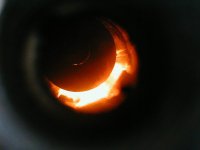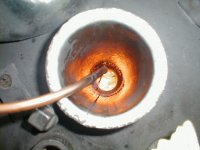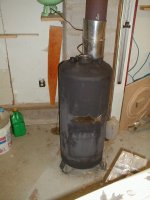You are using an out of date browser. It may not display this or other websites correctly.
You should upgrade or use an alternative browser.
You should upgrade or use an alternative browser.
Heating with waste oils
- Thread starter stnickstoys
- Start date
- Views: 8827
/ Heating with waste oils
#11
djradz
Veteran Member
Wow, that is some flame. Now, I looked at the Mother Earth instructions and you apparently made some changes. I (maybe like you) was concerned about smoke coming up the 3" or 4" pipe when starting the heater or when there wasn't maybe quite enough draft for the flue to suck it all out. Why did you go the route you did. Also, do you cover the 3" hole or what goes there when you're not taking cool pictures. Lastly, (at least for now /w3tcompact/icons/smile.gif), what size water heater tank did you use?
I don't cover up the pipe, which is what makes this thing burn so well, it needs a large amount of air. I know it looks like a problem but I only had it back up once when the wind was blowing around 40 miles per hour and the chimney was not heated up. My start up procedure is to put some mineral spirits in the lower part of the burner and one sheet of crumbled newspaper in the back of the stove to get the draft going. Light the paper and light the mineral spirits. The draft takes over from there. Start the drip of oil and in about five minutes the thing is cranking out heat. Once the burner is fully heated, adjust the oil to how much heat you want. When I first looked at the plans I thought it would never work, and smoke would come into the shop. That is why I had to build it, just to see if it would work.. I used a 40 gallon heater and cut in down to 3 ft tall.
This heater is not for everyone, as with any type of fire containing heater care must be taken when using. Some of the wood heaters that are being sold at home centers are scary to me, they are no more than a tin box.
This heater is not for everyone, as with any type of fire containing heater care must be taken when using. Some of the wood heaters that are being sold at home centers are scary to me, they are no more than a tin box.
JimM
New member
- Joined
- May 9, 2000
- Messages
- 9
- Location
- Pulaski Co, Science Hill,Ky
- Tractor
- Kubota M7030 3Pt.blade, Cary chipper-shredder,moldbd plow
What issue of Mother Earth are the plans in? Tnx, Jim
I got them off the internet at this site,
http://journeytoforever.org/biofuel_library/ethanol_motherearth/me4.html
http://journeytoforever.org/biofuel_library/ethanol_motherearth/me4.html
djradz
Veteran Member
Hope you don't mind some more questions. I'm thinking very seriously about going this route. Here goes:
Is your flue 6"?
How slow can you drip the oil? I'm thinking of using this in an insulated pole barn just to keep the temp above freezing.
At an extremely slow drip, will it stay lit?
Have you lost the flame yet and filled it with oil?
Do you filter the oil at all?
Have you run it yet on straight kerosene or diesel, and if so what was the result?
Is your flue 6"?
How slow can you drip the oil? I'm thinking of using this in an insulated pole barn just to keep the temp above freezing.
At an extremely slow drip, will it stay lit?
Have you lost the flame yet and filled it with oil?
Do you filter the oil at all?
Have you run it yet on straight kerosene or diesel, and if so what was the result?
No problem with the questions, I am learning every time I use the heater. My flue is 6 inches going into an 8X8 concrete block chimney. The oil I have been using is mostly from a fleet of service trucks that have mixed oils, gas and diesel with some Trans fluid mixed it. I need to mix fuel oil to make it flow through the 1/4 tubing. Without the fuel oil it would drip in at a rate about 1 drip per second, not enough to provide heat. When the heater gets burning the tube around the exhaust pipe heats up thus heating up the oil in it and flow increases. That is why you must keep an eye on it. The more oil that is fed the hotter it burns, flow increases, more oil, more heat and so on. No filter for the oil, I have a supply that has been in drums for many months, pump it off the top into five gallon cans, put in 2 gallons in feed tank at a time pre mixed with the fuel oil.
I have not lost a flame because I am burning it hot to get the shop heated fast. Then I burn at a steady rate to keep the heat coming. The oil is flowing in a stream rather dripping when using it. About a 1/16 stream. When the oil feed is shut off it stops burning with in minutes that is what I like about it. With wood you must wait until the fire is totally out before closing up the shop. I did not like going to bed knowing there was still a log burning in the stove. My wood stove was not in best of condition. That is what started me looking for alterative ways to heat shop.
The lowest rate will probability keep it burning but not produce much heat, that would be something that you would have to work with.
Putting straight fuel oil in it, might be asking for trouble, When it is burning some of the oil seems to vaporize before landing on top of the burner. Straight fuel might ignite in the intake and back up. Remember this is open to the shop. The main flame is inside the tank outside of the funnel. One of the photos shows this.
Hopefully this answers some of your questions.
I have not lost a flame because I am burning it hot to get the shop heated fast. Then I burn at a steady rate to keep the heat coming. The oil is flowing in a stream rather dripping when using it. About a 1/16 stream. When the oil feed is shut off it stops burning with in minutes that is what I like about it. With wood you must wait until the fire is totally out before closing up the shop. I did not like going to bed knowing there was still a log burning in the stove. My wood stove was not in best of condition. That is what started me looking for alterative ways to heat shop.
The lowest rate will probability keep it burning but not produce much heat, that would be something that you would have to work with.
Putting straight fuel oil in it, might be asking for trouble, When it is burning some of the oil seems to vaporize before landing on top of the burner. Straight fuel might ignite in the intake and back up. Remember this is open to the shop. The main flame is inside the tank outside of the funnel. One of the photos shows this.
Hopefully this answers some of your questions.



